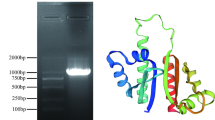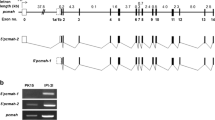Abstract
APC10 protein, a subunit of the anaphase-promoting complex (APC), plays an essential role in the progression of cells from mitosis to G1. In this study, we cloned and sequenced partial cDNA, intron 1 and 5′-flanking sequences of porcine APC10. The partial cDNA is 595 bp long and has an open reading frame of 558 bp which encodes 185 putative animo acids. Real-time PCR analysis revealed that the porcine APC10 mRNA expression shows a wide distribution and expression levels varies within a small different range in detected tissues. The deduced protein has a high identity with other eight species and comprises a conserved DOC domain. The phylogenetic tree indicated that porcine APC10 has the closest genetic relationship with human, monkey and dog. Promoter activity was demonstrated by transient transfection of 5′-deletion promoter/luciferase constructs into PK15 cells, and indicated that the proximal region from −2,052 to −1,764 is necessary for basal promoter activity. Positive cis-regulatory elements are present from −2,544 to −2,052 and from −3,114 to −2,774, while negative cis-regulatory elements may be present from −2,774 to −2,544. Yeast one-hybrid assay revealed Sp1 can interact with proximal promoter region of porcine APC10.








Similar content being viewed by others
References
Irniger S, Piatti S, Michaelis C, Nasmyth K (1995) Genes involved in sister chromatid separation are needed for B-type cyclin proteolysis in budding yeast. Cell 81:269–278
Sudakin V, Ganoth D, Dahan A, Heller H, Hershko J, Luca FC, Ruderman JV, Hershko A (1995) The cyclosome, a large complex containing cyclin-selective ubiquitin ligase activity, targets cyclins for destruction at the end of mitosis. Mol Biol Cell 6:185–197
King RW, Peters JM, Tugendreich S, Rolfe M, Hieter P, Kirschner MW (1995) A 20S complex containing CDC27 and CDC16 catalyzes the mitosis-specific conjugation of ubiquitin to cyclin B. Cell 81:279–288
Aristarkhov A, Eytan E, Moghe A, Admon A, Hershko A, Ruderman JV (1996) E2-C, a cyclin-selective ubiquitin carrier protein required for the destruction of mitotic cyclins. Proc Natl Acad Sci USA 93:4294–4299
Tang Z, Bharadwaj R, Li B, Yu H (2001) Mad2-independent inhibition of APCCdc20 by the mitotic checkpoint protein BubR1. Dev Cell 1:227–237
Takai N, Miyazaki T, Fujisawa K, Nasu K, Hamanaka R, Mitakawa I (2001) Polo-like kinase (PLK) expression in endometrial carcinoma. Cancer Lett 169:41–49
Honda K, Mihara H, Kato Y, Yamaguchi A, Tanaka H, Yasuda H, Furukawa K, Urano T (2000) Degradation of human aurora 2 protein kinase by the anaphase-promoting complex-ubiquitin-proteasome pathway. Oncogene 19:2812–2819
Stroschein SL, Bonni S, Wrana JL, Luo K (2001) Smad3 recruits the anaphase-promoting complex for ubiquitination and degradation of SnoN. Genes Dev 15:2822–2836
Baker DJ, Dawlaty MM, Galardy P, van Deursen JM (2007) Mitotic regulation of the anaphase-promoting complex. Cell Mol Life Sci 64:589–600
Wendt KS, Vodermaier HC, Jacob U, Gieffers C, Gmachl M, Peters JM, Huber R, Sondermann P (2001) Crystal structure of the APC10/DOC1 subunit of the human anaphase-promoting complex. Nat Struct Biol 8:784–788
Passmore LA, McCormack EA, Au SW, Paul A, Willison KR, Harper JW, Barford D (2003) Doc1 mediates the activity of the anaphase-promoting complex by contributing to substrate recognition. EMBO J 22:786–796
Carroll CW, Enquist-Newman M, Morgan DO (2005) The APC subunit Doc1 promotes recognition of the substrate destruction box. Curr Biol 15:11–18
Kominami K, Seth-Smith H, Toda T (1998) Apc10 and Ste9/Srw1, two regulators of the APC-cyclosome, as well as the CDK inhibitor Rum1 are required for G1 cell-cycle arrest in fission yeast. EMBO J 17:5388–5399
Grossberger R, Gieffers C, Zachariae W, Podtelejnikov AV, Schleiffer A, Nasmyth K, Mann M, Peters JM (1999) Characterization of the DOC1/APC10 subunit of the yeast and the human anaphase-promoting complex. J Biol Chem 274:14500–14507
Pravtcheva DD, Wise TL (2001) Disruption of Apc10/Doc1 in three alleles of oligosyndactylism. Genomics 72:78–87
Hwang LH, Murray AW (1997) A novel yeast screen for mitotic arrest mutants identifies DOC1, a new gene involved in cyclin proteolysis. Mol Biol Cell 8:1877–1887
Wise TL, Pravtcheval DD (2004) Oligosyndactylism mice have an inversion of chromosome 8. Genetics 168:2099–2112
Manouvrier-Hanu S, Holder-Espinasse M, Lyonnet S (1999) Genetics of limb anomalies in humans. Trends Genet 1999(15):409–417
Bernstein J (1992) Renal hypoplasia and dysplasia. In: Edelmann CM (ed) Pediatric kidney disease. Jr. Little Brown & Co, Boston, pp 1121–1137
Sorenson CM, Rogers SA, Hammerman MR (1996) Abnormal renal development in the Os/+ mouse is intrinsic to the kidney. Am J Physiol 271(1 Pt 2):F234–F238
Wang H, Zhu ZM, Wang HL, Yang SL, Li K (2007) Molecular cloning, mapping, and expression analysis of the EIF4A2 gene in pig. Biochem Genet 45(1–2):51–62
Shan TL, Tang ZL, Guo DZ, Yang SL, Mu YL, Ma YH, Guan WJ, Li K (2009) Partial molecular cloning, characterization, and analysis of the subcellular localization and expression patterns of the porcine OTUB1 gene. Mol Biol Rep 36(6):1573–1577
Li Y, Yang SL, Tang ZL, Cui WT, Mu YL, Chu MX, Zhao SH, Wu ZF, Peng KM, Li K (2010) Partial molecular characterization, expression pattern, polymorphism and association analysis of porcine SKP2 gene. Mol Biol Rep 37(3):1309–1317
Au SWN, Leng X, Harper JW, Barford D (2002) Implications for the ubiquitination reaction of the anaphase-promoting complex from the crystal structure of the Doc1/Apc10 subunit. J Mol Biol 316(4):955–968
Dynan WS, Tjian R (1983) The promoter-specific transcription factor Sp1 binds to upstream sequences in the SV40 early promoter. Cell 35:79–87
Briggs MR, Kadonaga JT, Bell SP et al (1986) Purification and biochemical characterization of the promoter-specific transcription factor, Sp1. Science 234:47–52
Kadonaga JT, Carner KR, Masiarz FR et al (1987) Isolation of cDNA encoding transcription factor Sp1 and functional analysis of the DNA binding domain. Cell 51:1079–1090
Kadonaga JT, Courey AJ, Ladika J et al (1988) Distinct regions of Sp1 modulate DNA binding and transcriptional activation. Science 242:1566–1570
Bucher P (1990) Weight matrix descriptions of four eukaryotic RNA polymerase II promoter elements derived from 502 unrelated promoter sequences. J Mol Biol 212:563–578
Qiao M, Wu HY, Li FE, Jiang SW, Xiong YZ, Deng CY (2009) Molecular characterization, expression profile and association analysis with carcass traits of porcine LCAT gene. Mol Biol Rep. Aug 12. [Epub ahead of print]
Wang L, Wei D, Huang S et al (2003) Transcription factor Sp1 expression is a significant predictor of survival in human gastric cancer. Clin Cancer Res 9:6371–6380
Zannetti A, Del VS, Carriero MV et al (2000) Coordinate upregulation of Sp1 DNA-binding activity and urokinase receptor expression in breast carcinoma. Cancer Res 60:1546–1551
Chiefari E, Brunetti A, Arturi F et al (2002) Increased expression of AP2 and Sp1 transcription factors in human thyroid tumours: a role in NIS expression regulation? BMC Cancer 2:35
Shi Q, Le X, Abbruzzese JL et al (2001) Constitutive Sp1 activity is essential for differential constitutive expression of vascular endothelial growth factor in human pancreatic adenocarcinoma. Cancer Res 61:4143–4154
Acknowledgements
This work was supported by Key Project of National Natural Science Foundation of China (30830080), National High Science and Technology Foundation of China (2008AA10Z135), Key Project of National Basic Research and Development Plan of China (2006CB102105), National Natural Science Foundation of China (30571300), National Support Plan (2006BAD13B08-1) and Innovation Group Foundation of CAAS.
Author information
Authors and Affiliations
Corresponding authors
Rights and permissions
About this article
Cite this article
He, W.B., Wang, Z.W., Li, Y. et al. Sequence characterization and promoter identification of porcine APC10 gene. Mol Biol Rep 37, 3841–3849 (2010). https://doi.org/10.1007/s11033-010-0040-3
Received:
Accepted:
Published:
Issue Date:
DOI: https://doi.org/10.1007/s11033-010-0040-3




